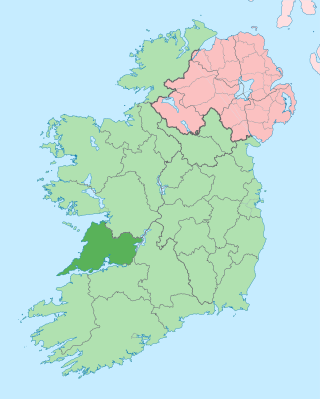
County Donegal was a UK Parliament constituency in Ireland, returning two Members of Parliament (MPs).
County Down was a UK Parliament constituency in Ireland. It was a two-member constituency and existed in two periods, 1801–1885 and 1922–1950.
County Cavan was a parliamentary constituency in Ireland, which from 1801 to 1885 returned two Members of Parliament (MPs) to the House of Commons of the United Kingdom of Great Britain and Ireland.

County Clare was a parliamentary constituency in Ireland, represented in the Parliament of the United Kingdom. From 1801 to 1885 it returned two Members of Parliament (MPs) to the House of Commons of the United Kingdom of Great Britain and Ireland.
County Cork was a parliamentary constituency in Ireland, represented in the Parliament of the United Kingdom. From 1801 to 1885 it returned two Members of Parliament (MPs) to the House of Commons of the United Kingdom of Great Britain and Ireland.

Dublin County was a parliamentary constituency in Ireland, which returned two Members of Parliament (MPs) to the House of Commons of the Parliament of the United Kingdom.
A former UK Parliament constituency in Ireland, returning two MPs to the United Kingdom House of Commons.
County Kilkenny was a former UK Parliament county constituency in County Kilkenny in Ireland. The County constituency returned two Members of Parliaments (MPs) in the House of Commons of the United Kingdom of Great Britain and Ireland, from 1801 until 1885.
County Limerick was a parliamentary constituency in Ireland, which returned two Members of Parliament (MPs) to the House of Commons of the Parliament of the United Kingdom from 1801 to 1885.
County Mayo was a parliamentary constituency in Ireland, which returned two Members of Parliament (MPs) to the House of Commons of the Parliament of the United Kingdom from 1801 to 1885.
County Louth, otherwise known as Louth County or Louth, is a former parliamentary constituency in Ireland, which was represented in the House of Commons of the Parliament of the United Kingdom. From 1801 to 1885 it returned two Members of Parliament (MPs), and one from 1918 to 1922.
County Westmeath is a former UK Parliament constituency in Ireland, returning two Members of Parliament from 1801 to 1885 and one from 1918 to 1922.
County Sligo is a former county constituency in Ireland, represented in the House of Commons of the Parliament of the United Kingdom. It returned two Members of Parliament (MPs), elected by the bloc vote system of election.
County Wexford was a UK Parliament constituency in Ireland, which returned two Members of Parliament (MPs) to the United Kingdom House of Commons.
County Wicklow was a parliamentary constituency in Ireland, represented in the Parliament of the United Kingdom. From 1801 to 1885 it returned two Members of Parliament (MPs) to the House of Commons of the United Kingdom of Great Britain and Ireland.
Sligo Borough is a former borough constituency in Ireland, represented in the House of Commons of the Parliament of the United Kingdom.
Drogheda was a parliamentary borough constituency in Ireland, which returned one Member of Parliament (MP) to the House of Commons of the Parliament of the United Kingdom. It was an original constituency represented in Parliament when the Union of Great Britain and Ireland took effect on 1 January 1801, replacing the Drogheda constituency in the Irish House of Commons.
Kinsale was a United Kingdom Parliament constituency in Ireland, returning one MP. It was an original constituency represented in Parliament when the Union of Great Britain and Ireland took effect on 1 January 1801.
Kilkenny City was an Irish borough constituency in the House of Commons of the United Kingdom of Great Britain and Ireland, returning one Member of Parliament (MP). It was an original constituency represented in Parliament when the Union of Great Britain and Ireland took effect on 1 January 1801, and remained in existence until its abolition at the 1918 general election.
Galway Borough was a United Kingdom Parliament constituency in Ireland. It returned one MP from 1801 to 1832, two MPs from 1832 to 1885 and one MP from 1885 to 1918. It was an original constituency represented in Parliament when the Union of Great Britain and Ireland took effect on 1 January 1801.


